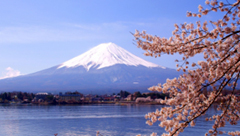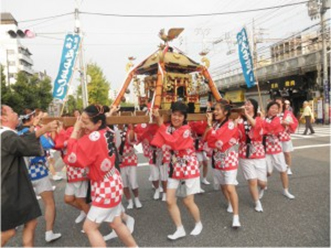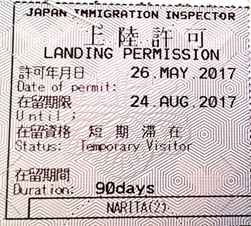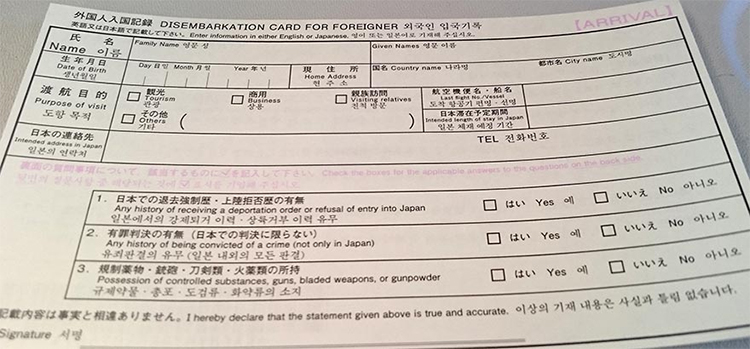Japan in brief
Japan – the “Land of the Rising sun” – is an archipelago of more than 6,800 islands in the Pacific Ocean. The main islands are, from North to South: Hokkaido, Honshu, Shikoku, Kyushu, which make up for 97% of the land of Japan. Its population is more than 126 millions inhabitants. Japan is the 3rd largest economy in the world, based on GDP.
Japan’s climate is temperate, though it is worth noticing that there are wide discrepancies between North and South, from Hokkaido to Kyushu, as Japan extends about 3,000 km of latitude.
Landscapes

About three quarters of the land of Japan is made of forests and mountains. This is the reason why Japan features a very high population density and huge metropolises, most of which are situated on the coasts.
The archipelago is located on a large volcanic zone – it has more than a hundred active volcanoes.
Cities
Japan’s population is mostly urban and there are large cities and metropolises indeed. The Tokyo-Yokohama urban area is the largest area in the world (about 38 millions inhabitants). Osaka and Nagoya are also large cities with respectively 2.7 and 2.3 inhabitants in the inner-city.
Politics

Japan is a liberal democracy, a constitutional monarchy on the model of the United Kingdom.
Its current constitution was enacted in 1947, when Japan was still occupied by the Allies. It defines Japan’s parliamentary system and guarantees fundamental rights.
The emperor has a honorific role only. Since 1955, the LDP (Liberal Democratic Party) has been ruling except for 2 brief interludes.
Economy

Japan is a developed country – the fifth largest importer and exporter in the world. It is a major industrial and economic power, 3rd largest economy in terms of GDP and, as such, it is part of the G7 and G20. Many Japanese companies are among the world’s largest and most profitable ones, among which Honda, Toyota, Hitachi, Softbank, Canon, Mitsubishi, Toshiba, to name a few.
Education
Japanese education system is excellent, as evidenced by its illiteracy rate of 0%. Most children go to senior high schools, and, in turn, most of them then go to higher education institutions. As of 2013, Japan had 2 universities ranked in the World’s top-30, 3 in the top-100, 9 in the top-200. For more information on the Japanese Education System, please click here.
Health
Japanese people benefit from a universal health insurance system. Life expectancy in Japan is the highest of the world, while infant mortality is the third lowest. For information about Health insurance, click here.
Research and innovation

Japan is one of the world leaders in terms of funds allocated to research. Consequently, it is at the top of research in various fields, and it has produced many Nobel Prize laureates (22 since 1949).
Thanks to a very competitive and efficient education system – in particular higher education institutions – Japan is a significant contributor to science, in all fields and industries.
Traditions
Japan has an ancient history and thus strong traditions that are still very much in use nowadays. Traditions are a major factor in the renowned Japanese society cohesiveness. For newcomers, it is fascinating to discover what makes Japan so special. It is, really, a fascinating “world”.
Culture and Art

Japanese culture is unique. Japanese language students always learn more than a language – which is unique in itself. They also learn the deep meanings and values of an ancient culture.
Aesthetics and creativity remain prominent in Japan. Calligraphy, painting (the famous Ukiyo-e), ikebana (flower arrangement), pottery, lacquerware, theatre (Noh, Kabuki …), manga, to name the most famous ones: Japan art is immensely rich and varied.
Cuisine

Japanese cuisine is much more than sushi and yakitori. It is actually very diverse and it has become an art – Japanese restaurants have more Michelin stars than restaurants of any other country. It is a delight to discover new Japanese meals, foods and nutrients, which also happen to often be very healthy.
Japanese gastronomy has also been added to UNESCO’s World Heritage.
Demographics and Immigration
Composed of more than 98% of ethnic Japanese, Japan has been known to be rather closed to immigration. As the world gets global, things are changing in Japan too. The government has publicly expressed the need for Japan to open up to immigration, in particular to students. A campaign has been launched to double the number of foreign students in Japan by 2020.
Why study in Japan?
Japan is an increasingly popular and attractive destination for students. As of May 1, 2010, there were about 140,000 foreign students in Japan. The Japanese government is expecting that number to increase to 300,000 by the year 2020.
Whether your aim is simply to learn the Japanese language because you are deeply interested in Japanese culture, or you intend to study and/or work in Japan, it is a great idea to learn the language in its country itself. It will be one of the exciting time of your life and a great stepping stone for your life and your career.
So, WHY study in Japan?

1.Make the most of an excellent education system– and tuition fees that are quite lower than other developed countries. What you will learn in Japan will prepare you and will have you ready for even the most competitive job markets. Learning the Japanese language will allow you to enroll in a university and obtain a highly respected degree and eventually open more opportunities for you.
2. Once you have completed your courses and achieved a good JLPT score (JLPT N2 should be your target), you will be in a good situation to seek a position at a Japanese company. Should you decide to stay in Japan, a lot of opportunities will unfold. The Japanese job market is a very dynamic one and the Japanese economy is the third in the world.
3. If you decide to leave Japan and after you have finished your language courses, your experience and skills will be very valuable to potential employers, be it in your country or anywhere else in the world. The Japanese language will surely bring more opportunities.

4. The Japanese government is opening up more opportunities for foreign nationals, including offering different type of visas to cater the shortage of manpower. If you are still thinking when the right time to study Japanese is, the answer is, now is the right time.
5. You will learn the Japanese language faster by studying in Japan rather than simply studying it abroad. It is usually believed that it takes 10 months (with hard work) to 1 year to achieve a Level 2 JLPT score, whereas it would take much longer (likely years) if you were staying in abroad.
6. Discover a rich and fascinating culture. Japan is also the land of innovation and creativity. Beyond the language, there is so much to learn in Japan. Never-ending opportunities for amazing experiences and discoveries.
7. Enjoy a peaceful life. Japan is one of the safest developed countries in the world. Walk in the middle of the night in a deserted street with no fear. Even if you forget your wallet at a bar, there is a very good chance it will remain there until you pick it up!
8. Great life condition: You will have access to great healthcare, transportation system, affordable tasty and healthy food, great services, Japanese sub culture and modern accommodations with all the comfort you need.
9. You will find that the cost of living is not so high. There are many ways for you to save money. Check out our blogs on different ways to save money in Japan.
Foreign students can work up to 28 hours per week in Japan and 40 hours on long holiday. Most of the students chose to work long hours on their long school breaks rather than travel or go back to their country so they can save more money (for their future plans like Senmon Gakko) which they cannot do during normal school days.
STUDENT VISA TO JAPAN
Do you want to study in Japan? Then you will most likely need a visa. In this guide, we take you through the application process step by step. We can also help with schools in Japan.
1. Determine which visa you need
Which visa you need depends on how long you are going to study in Japan:

Short term courses up to 90 days: many nationalities can visit Japan for up to 90 days on visa waiver. When you arrive in Japan you will get a sticker in your passport which shows that you can stay in Japan for 90 days. During that time you can, for example, take a language course in Japan. Read more about which nationalities can travel to Japan on visa waiver. If you travel on visa waiver you must have a return ticket within 90 days.
More than 90 days but less than 20 weeks: citizens of some countries like Germany, Ireland, Switzerland, and the UK can extend their period of stay with 90 more days by applying to the Ministry of Justice in Japan before their first 90 days have expired (read more on the link above).
For other nationalities stays of this kind of length is trickier. Schools usually won’t issue a student visa for less than 20 weeks so your only solution would be to do a so called “visa run” by staying for 90 days in Japan and then travel to a nearby country like Korea and return to Japan for another 90 days upon re-entry. The Japanese authorities don’t like this solution but to do it once usually works without any problem but for longer stays, you should get a student visa. To do this you must have booked your exit ticket when you enter Japan the first time.
Long term courses 20 weeks-2 years: For courses that are 20 weeks (two quarters) or longer you can and should apply for a student visa following the procedure below. Prospective students must be 18 years old or more, and have completed high School or above with a minimum of 12 years in school in order to get a student visa to Japan.
2. Apply to a school in Japan
Once you have decided on how long you want to study it is time to apply to a school in Japan. If you will take a long term course and apply for a student visa the application process is done through your school. Their deadline for visa applications is often about five months before the course starts so make sure to apply earlier than that so you have time to complete all the documentation. High ranking language schools and universities sometimes can take later applications too.
If you only take a short term course on visa waiver in Japan you can skip directly to step 8.
Fill in an information request so we can help you to find language schools in Japan.
Infromation request form
3. Fill in the school’s visa application documents
To apply for a student visa to Japan is a multiple step process. First, you fill in different visa application documents and submit to your school. Then the school checks that your application is complete before they rewrite it and submit it to the immigration authorities in Japan. Then you will eventually get a Certificate of Eligibility (step 4) that you need for the final step of your visa application.
Once you apply to a school they will send you (or ask you to download) the following documents that you need to fill in and submit to the school:
- An application form where you fill in data about yourself and the course. Make sure to always write your name as it is written in your passport.
- A personal history form where you fill in your educational and occupational history. Fill in as much as possible. Any blank periods will need to be explained. On this form or a separate form, you will also have to fill in some details about your family members.
- Application essay motivate why you want to study in Japan. Write more than 1-2 sentences and if you are a bit older it is good to write how your studies in Japan can benefit your career.
- Diploma and transcript from the last school you have graduated from translated to English or Japanese.
- Certificate of previous Japanese studies if applicable.
- A copy of your passport the photo page.
- Passport photos schools usually want 8 photos. However, nowadays a few schools can accept digital photos.
- Medical history some schools ask for your medical history or a tuberculosis check up but many schools don’t.
You also need to prove that you can pay for your course and support yourself in Japan. For this you usually need to submit:
- A letter of remittance where you state how much money you will have in Japan and whether it is your money or if you have a guarantor. The money you list should cover the tuition fees and your living costs.
- A bank account balance certificate showing that you or your guarantor have the needed money (usually at least 1600000 Yen).
- Proof of employment for you or your sponsor.
- A written oath or pledge from you or your guarantor that you promise to pay the required costs.
The schools create their own application documents so sometimes more or less documentation is needed. I know it can seem overwhelming but just follow the instructions and fill in what you can. The school will then check your documentation and let you know if anything is missing.
4. Get your CoE
After the school has accepted your application, they will submit it to the immigration authorities. About one month before your course starts they will issue a Certificate of Enrollment, CoE, that you need for step 5. The school will send you the CoE as soon as it has been issued and you have paid for your first semesters. Make sure that the school has your correct address and that you pay them on time.
Theoretically, the Japanese immigration authorities can deny you a CoE but that almost never happens for Western students. However, if you apply late or if your application is incomplete or if you are just unlucky your CoE might arrive close to the start of your course giving you some time pressure so do what you can to avoid that.
5. Apply at the Japanese Embassy located at Panipokhari, Kathmandu
The final step to get a student visa to Japan is to make the visa application at the Japanese Embassy. To do this you need to submit:
- Your CoE (Original)
- Your passport (Original)
- A photo (2” * 2”)
- A visa application form filled in digitally or by hand using block letters. Write your school as guarantor “Guarantor or reference in Japan” unless they have instructed you otherwise.
- Copy of the Japanese Language Study Certificate
- Copy of the certificate of Japanese Language Proficiency Test (JLPT) / NAT Test
For more information see the website of the Japanese Embassy. Please note that you need to complete this process and get your visa before you arrive in Japan.
6. Get your visa
So finally you are done!
If you submit a complete application you will almost always get your visa from the Japanese Embassy. However, they can deny you if the information is incomplete or if you, for example, have some serious criminal record.
How long it takes depends on where you are applying but you are usually recommended to apply at least two weeks before you travel to Japan.
7. Fly to Japan and when to book your tickets
Time to travel to Japan and start your studies! You might wonder when in the process you should book your flight tickets?
The Japanese authorities recommend that you don’t book your tickets until you have gotten your visa (step 6). However, we recommend that you book a flight just the weekend before your course starts.
8. Arriving in Japan – landing card and work permit
When you land in Japan you will be asked to fill in a landing card (see the image below). Make sure that you have the necessary information available. Under Purpose of visit, you can fill in Others: study. If you come on visa waiver you might be asked some more questions about your plans but as long as you answer honestly and don’t plan to stay longer than 90 days before leaving Japan you should be fine. If you write tourism they usually don’t ask any questions unless you plan to stay long. If you do a visa run I advise that you ask your school for advice.

If you have a student visa and want to work in Japan it is a good idea to apply for a work permit (Permission to Engage in Activity Other than that Permitted by the Status of Residence Previously Granted) at the immigrations in the airport when you first arrive in Japan. Then you can get it immediately otherwise it takes some time and work. Here you can download the form for applying for work permit in the airport.
In the passport control student visa holders will usually also get their Residence Card, your Japanese id-card, that you should always carry when you are in Japan on a student visa.
Yes Japanese administration can drive anyone crazy, but believe me, it is worth it to give you the chance to study in Japan.
Disclaimer: Please note that the Japanese authorities can make changes to the visa application process without notifying us. Different rules can apply to different nationalities so always read the instructions from your school carefully. The information in the article above is correct to the best of our knowledge but we cannot be held responsible for any error that might occur without our knowledge. When in doubt always trust the official sources and check with them if needed.
More information
Read more about universities and language schools in Japan and student housing in Japan.
Follow Revolution Education Academy Pvt. Ltd. on Facebook or Instagram or youtube or twitter to get updated about our new schools and articles.
News & Events
 𝐆𝐥𝐢𝐦𝐩𝐬𝐞 𝐨𝐟 𝐑𝐞𝐯𝐨𝐥𝐮𝐭𝐢𝐨𝐧 𝐄𝐝𝐮𝐜𝐚𝐭𝐢𝐨𝐧 𝐅𝐚𝐢𝐫❤️✨🎉
𝐆𝐥𝐢𝐦𝐩𝐬𝐞 𝐨𝐟 𝐑𝐞𝐯𝐨𝐥𝐮𝐭𝐢𝐨𝐧 𝐄𝐝𝐮𝐜𝐚𝐭𝐢𝐨𝐧 𝐅𝐚𝐢𝐫❤️✨🎉
 𝐑𝐞𝐯𝐨𝐥𝐮𝐭𝐢𝐨𝐧 𝐄𝐝𝐮𝐜𝐚𝐭𝐢𝐨𝐧 𝐅𝐚𝐢𝐫 𝐜𝐨𝐧𝐝𝐮𝐜𝐭𝐞𝐝 𝐬𝐮𝐜𝐞𝐬𝐬𝐟𝐮𝐥𝐥𝐲❤️✨🎉
𝐑𝐞𝐯𝐨𝐥𝐮𝐭𝐢𝐨𝐧 𝐄𝐝𝐮𝐜𝐚𝐭𝐢𝐨𝐧 𝐅𝐚𝐢𝐫 𝐜𝐨𝐧𝐝𝐮𝐜𝐭𝐞𝐝 𝐬𝐮𝐜𝐞𝐬𝐬𝐟𝐮𝐥𝐥𝐲❤️✨🎉
 𝐑𝐞𝐯𝐨𝐥𝐮𝐭𝐢𝐨𝐧 𝐄𝐝𝐮𝐜𝐚𝐭𝐢𝐨𝐧 𝐅𝐚𝐢𝐫 : 𝐎𝐩𝐞𝐧𝐢𝐧𝐠 𝐚𝐧𝐝 𝐂𝐥𝐨𝐬𝐢𝐧𝐠 𝐂𝐞𝐫𝐞𝐦𝐨𝐧𝐲❤️✨🎉
𝐑𝐞𝐯𝐨𝐥𝐮𝐭𝐢𝐨𝐧 𝐄𝐝𝐮𝐜𝐚𝐭𝐢𝐨𝐧 𝐅𝐚𝐢𝐫 : 𝐎𝐩𝐞𝐧𝐢𝐧𝐠 𝐚𝐧𝐝 𝐂𝐥𝐨𝐬𝐢𝐧𝐠 𝐂𝐞𝐫𝐞𝐦𝐨𝐧𝐲❤️✨🎉
Student Says

Birendra Saud- UK🇬🇧
My whole processing was done at last minute. Thankfully, Revolution helped me issue offer and started documentation quickly. My whole documentation process couldn’t be more smoother. Even after Visa Grant, I was guided by whole revolution team for pre departures too. Therefore, I couldn’t be anymore Thankful.
